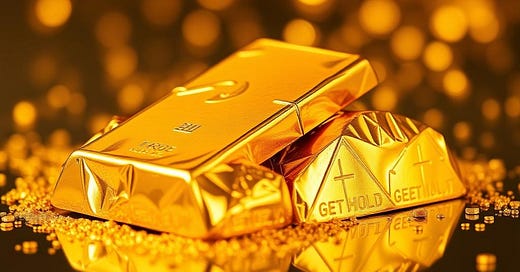roughout history, gold was never seen as just a lustrous yellow metal but rather as a prized possession that symbolizes wealth, prosperity, and success. From the Gold Rush of 1848, which revolutionized the American economy and development, to the recent gold rally of 2025 due to various economy-related fears, there may be another gold rush on its way, but this time, it is more modern and more global.
After gold was discovered at Sutter’s Mill in 1848, it paved the way for economic growth and social and urban development, creating a lasting dynamic that adds to its pricelessness. In fact, more than 90% of all gold mined since recorded human history was extracted after 1848, marking the beginning of the Gold Rush. As word of this golden opportunity spread, California and the United States experienced a massive influx of both immigrants and migrants who were on the hunt for gold, with more than 100,000 people flooding into California. With the inflow of wealth, gold, and people, California eventually needed a government to oversee it’s activities.This prompted California to receive its statehood in 1850, only two years after the gold rush emerged. A variety of industries boomed during this time, including agriculture, lumber, and transportation, and some of the most famous companies we know today began their ventures during this time: Wells Fargo & Co and Levi Strauss.
Gold is commonly seen as a safe-haven asset, distinguishing it from other asset classes due to its performance during economic cycles and ability to store value, unlike other commodities. Like any item, gold prices are also susceptible to supply and demand. When inflation rises, gold prices also rise, as investors aim to protect their purchasing power and hedge against uncertainty or volatility. During the 17th and 18th century, gold was tied to a specific amount of currency, leading to the gold standard– a currency where paper notes and gold could be exchanged for a fixed rate. Once the U.S. switched to fiat currency, the price of gold skyrocketed, as it was no longer tied to a currency for a fixed amount. This uptick in gold leads to more purchases and it being allocated into portfolios, with the most common ways to invest in gold being physical bullions, coins, or gold-based ETFs, which tend to be more convenient for those who do not want to physically own gold.
With gold already crossing $2,954.97 on February 20, 2025, and an increase in gold prices by 78% in the last 5 years, many investors believe now is the right time to pour money into gold. President Trump’s recent tariff announcement has also added upward pressure to gold, with plans to impose 25% tariffs on imported steel and aluminum and lingering fears of trade wars, gold appears more attractive, especially because many central banks have also been buying up gold for their reserves. On January 27, 2025, the tech sector of the stock market underwent a sudden shock with the rise of DeepSeek, a Chinese AI company that claims to be more efficient than OpenAI, has caused big tech companies to fall and gold to climb tall.
Not all that glitters is gold, especially when it comes to the environmental damages of gold mining. With an average of 9.7 metric tons of gold extracted daily, water pollution and contamination, deforestation, CO2 emissions, and mercury pollution are inevitable.
While gold remains valuable, there might be a rush for a more modern gold: rare earth metals. Rare earth metals, including lithium, neodymium, and praseodymium, are being used in producing wind turbines and solar panels, EV batteries, semiconductors, and catalytic converters, in an effort to make energy usage more efficient. As we shift towards a cleaner, greener earth, the demand for clean energy and technology has led to a demand for rare earth minerals, as we discover more utility to metals other than gold.
All in all, gold continues to remain a golden asset, with new earth metals and tariffs on the rise and will continue to grow in the near future.







